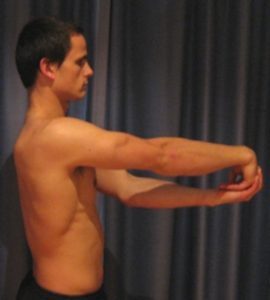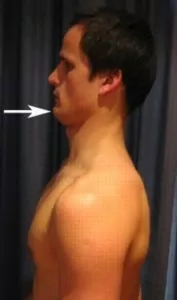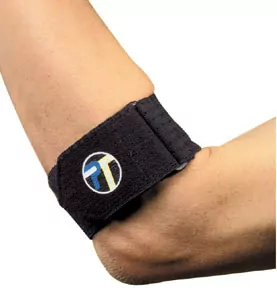Tennis Elbow (Lateral Epicondylitis)
Updated:
(Also known as Lateral Epicondylitis, Extensor Tendinopathy, Extensor Carpi Radialis Brevis Tendinopathy)
What is tennis elbow?
Tennis elbow is a common overuse injury which typically causes pain at the outer aspect of the elbow. Although it can occur at any age, it is commonly seen in patients between the ages of 40 and 50.
The group of muscles at the back of the forearm are commonly called the forearm extensors (figure 1). These muscles act to extend the wrist and fingers (i.e. bend the wrist backwards and straighten the fingers) and have a common bony attachment at the outer aspect of the elbow called the lateral epicondyle (figure 1). The forearm extensors attach to the lateral epicondyle via the extensor tendon.

During contraction of the forearm extensors, tension is placed through the extensor tendon at its attachment to the lateral epicondyle. When this tension is excessive due to too much repetition or high force, damage to the tendon occurs. Tennis elbow is a condition whereby there is damage, with subsequent inflammation and degeneration of the extensor tendon at its bony attachment to the outer elbow. It usually occurs due to gradual wear and tear associated with overuse, however, the condition may also occur traumatically due to a specific incident. The extensor muscle that is most commonly affected in this condition is known as the extensor carpi radialis brevis.
Causes of tennis elbow
Contrary to what the name suggests, you do not have to play tennis to develop this condition. In fact, tennis elbow is more commonly seen in non-tennis players than in tennis players. Patients typically develop this condition in association with activities involving repeated wrist extension against resistance. This includes sporting activities such as tennis, squash, badminton, as well as manual work such as carpentry, painting, chopping wood, bricklaying, repetitive use of a screwdriver, sewing and knitting or working at a computer. Patients may also develop this condition from other activities involving repetitive or forceful gripping of the hand.
It is common for patients to develop this condition following a sudden increase in activities that place stress on the forearm extensors (such as involvement in a tennis tournament over consecutive days) or due to a change in these activities (such as hitting balls in the wet, hitting into a strong breeze, tightening the tennis racquet’s strings, using a new tennis racquet or technique, or simply hitting the ball too hard). Occasionally, the condition may develop suddenly. This is usually due to a forceful movement involving a heavy lifting or gripping force through the arm. In tennis players, tennis elbow is often associated with poor backhand technique. A history of wrist, elbow, shoulder or neck injury may also increase the likelihood of developing this condition.
Signs and symptoms of tennis elbow
The symptoms associated with this condition usually develop gradually over a period of time. Initially, symptoms may present as an ache following an aggravating or unaccustomed activity. This may often be felt first thing in the morning. Patients usually experience localized elbow pain 1-2cm down from the bony lump on the outer aspect of the elbow (lateral epicondyle – figure 1) that increases on firmly touching this region. Occasionally, pain may radiate into the forearm.
In less severe cases of this condition, patients may only experience a minor ache. In more severe cases, pain may be quite incapacitating and can keep the patient awake at night. Usually pain is experienced as an ache that increases to a sharper pain with activity. Occasionally, this condition can be associated with neck or upper back pain on the same side. In longstanding cases muscle weakness and reduced grip strength may also be present.
Patients with tennis elbow often experience an increase in pain during everyday activities such as gripping activities, picking up a cup, turning a door knob, opening a jar, shaking hands, carrying groceries or turning the steering wheel of a car. Elbow stiffness may also be experienced and is typically worse first thing in the morning.
Diagnosis of tennis elbow
A thorough subjective and objective examination from a physiotherapist is usually sufficient to diagnose tennis elbow. Further investigations such as an MRI scan or Ultrasound may be required, in rare cases, to confirm diagnosis.
Treatment for tennis elbow

Members Only ContentBecome a PhysioAdvisor Member to gain full access to this exclusive content. For more details see Become a Member. Already a member? Login Now
Prognosis of tennis elbow
With appropriate management, most minor cases of tennis elbow that have not been present for long can usually recover within a few weeks. In more severe and chronic cases recovery can be a lengthy process and may take up to 6 months in those who have had their condition for a long period of time. Early physiotherapy intervention is therefore vital to hasten recovery.
Contributing factors to the development of tennis elbow
There are several factors which can predispose patients to developing this condition. These need to be assessed and corrected with direction from a physiotherapist. Some of these factors include:
- excessive or inappropriate activity
- poor sporting technique or equipment
- muscle weakness
- muscle tightness
- joint tightness (particularly the wrist, elbow, neck or upper back)
- poor posture
- inadequate warm-up
- inadequate rehabilitation following a previous elbow injury
- a history of neck or upper back injury
- a history of injury to the nerves that supply the elbow
In tennis players, inappropriate racquet size, grip size, string tension, court surface or ball weight may all contribute to the development of this condition.
Physiotherapy for tennis elbow
Physiotherapy treatment for this condition is vital to hasten the healing process, ensure an optimal outcome and reduce the likelihood of injury recurrence. Treatment may comprise:
- soft tissue massage
- electrotherapy
- taping
- the use of a tennis elbow brace
- joint mobilization
- dry needling
- ice or heat treatment
- progressive exercises to improve flexibility, strength & posture
- training and activity modification advice
- technique correction
- education
- anti-inflammatory advice
- devising and monitoring an appropriate return to sport or activity plan
Other intervention
Despite appropriate physiotherapy management, some patients with this condition do not improve. When this occurs the treating physiotherapist or doctor can advise on the best course of management. This may include X-rays, ultrasound or MRI investigations, pharmaceutical intervention, corticosteroid injection, autologous blood injection or referral to appropriate medical authorities who can advise on any intervention that may be appropriate to improve the condition. In very rare, chronic cases of tennis elbow, surgical intervention may be considered.
Exercises for tennis elbow
The following exercises are commonly prescribed to patients with this condition. You should discuss the suitability of these exercises with your physiotherapist prior to beginning them. Generally, they should be performed 2 – 3 times daily and only provided they do not cause or increase symptoms.
Your physiotherapist can advise when it is appropriate to begin the initial exercises and eventually progress to the intermediate, advanced and other exercises. As a general rule, addition of exercises or progression to more advanced exercises should take place provided there is no increase in symptoms.
Initial Exercises
Tennis Elbow Stretch
Begin this exercise by keeping your elbow straight (figure 2). Slowly bend your wrist down using your other hand until you feel a mild to moderate stretch pain free. Hold for 15 seconds and repeat 4 times.

Chin Tucks
Begin sitting or standing tall with your back and neck straight, shoulders should be back slightly. Tuck your chin in until you feel a mild to moderate stretch pain free (figure 3). Keep your eyes and nose facing forwards. Hold for 2 seconds and repeat 10 times provided there is no increase in symptoms.

Shoulder Blade Squeezes
Begin this exercise by standing or sitting with your back straight. Your chin should be tucked in slightly and your shoulders should be back slightly. Slowly squeeze your shoulder blades together as far as possible pain free (figure 4). Hold for 5 seconds and repeat 10 times provided there is no increase in symptoms.

Intermediate Exercises

Members Only ContentBecome a PhysioAdvisor Member to gain full access to this exclusive content. For more details see Become a Member. Already a member? Login Now
Advanced Exercises

Members Only ContentBecome a PhysioAdvisor Member to gain full access to this exclusive content. For more details see Become a Member. Already a member? Login Now
Other Exercises

Members Only ContentBecome a PhysioAdvisor Member to gain full access to this exclusive content. For more details see Become a Member. Already a member? Login Now
Rehabilitation Protocol for tennis elbow

Members Only ContentBecome a PhysioAdvisor Member to gain full access to this exclusive content. For more details see Become a Member. Already a member? Login Now
 Physiotherapy products for tennis elbow
Physiotherapy products for tennis elbow
Some of the most commonly recommended products by physiotherapists to hasten healing and speed recovery in patients with this condition include:
To purchase physiotherapy products for tennis elbow click on one of the above links or visit the PhysioAdvisor Shop.
 Find a Physio
Find a Physio
Find a physiotherapist in your local area to treat tennis elbow.
 More Information
More Information
- Wrist Strengthening Exercises.
- Wrist Stretches.
- Elbow Strengthening Exercises.
- Elbow Stretches.
- Tennis Elbow Taping.
- View detailed information about when to use Ice or Heat.
- Read more about initial injury management and the R.I.C.E. Regime.
- Why is my injury not improving?
- View our Elbow & Forearm Diagnosis Guide.
Become a PhysioAdvisor Member
-
 Individual Membership (12 Months)$59.95 for 1 year
Individual Membership (12 Months)$59.95 for 1 year -
 Individual Membership (3 Months)$39.95 for 3 months
Individual Membership (3 Months)$39.95 for 3 months -
 Individual Membership (Yearly)$49.95 / year
Individual Membership (Yearly)$49.95 / year -
 Individual Membership (Monthly)$15.95 / month
Individual Membership (Monthly)$15.95 / month

Link to this Page
If you would like to link to this article on your website, simply copy the code below and add it to your page:
<a href="https://physioadvisor.com.au/injuries/elbow-forearm/tennis-elbow-lateral-epicondylitis”>Tennis Elbow (Lateral Epicondylitis) – PhysioAdvisor.com</a><br/>Tennis elbow is a common overuse injury typically causing pain at the outer aspect of the elbow. Explore its causes, symptoms & treatment at PhysioAdvisor.
Return to the top of Tennis Elbow (Lateral Epicondylitis).









